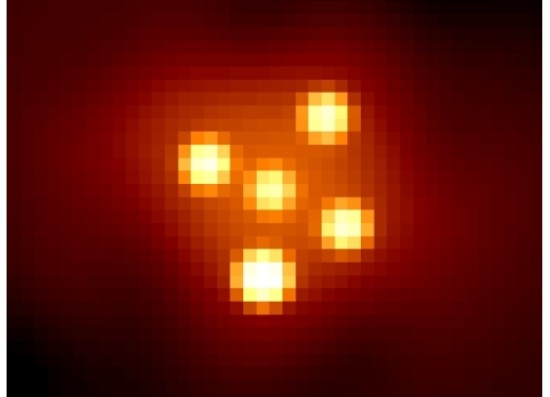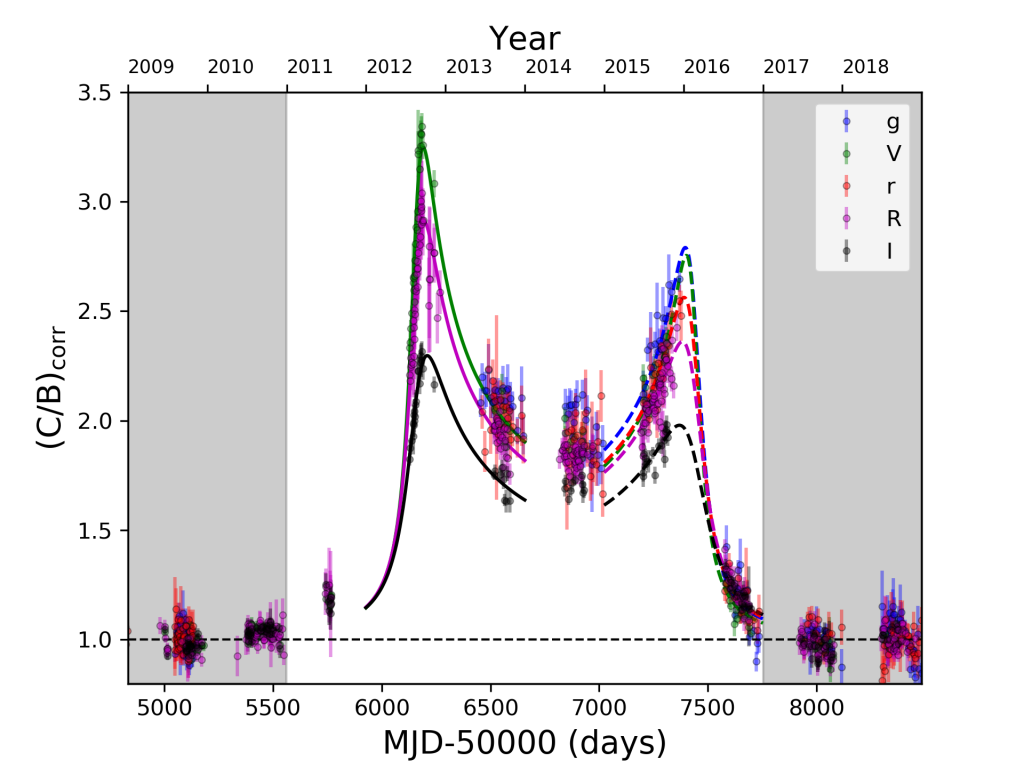
The Einstein Cross consists of four images (A, B, C, and D) of a distant quasar that is located about 8,000 million light years from Earth. The A-D images are arranged like a cross around the nucleus of a nearly face-on spiral galaxy at a distance of 400 million light years (see Fig. 1 above). The light of this quadruply-imaged quasar passes through four different regions in the bulge of the lensing spiral galaxy, and thus each quasar image is gravitationally affected by a different stellar population. These stellar populations are responsible for the so-called microlensing effects.
Microlenses (stars) affect each gas ring in an accretion disc to a different extent, so that more compact (hotter and bluer) sources are expected to suffer stronger effects. Therefore a monitoring of the multi-wavelength microlensing-induced variability of a lensed quasar can be used to probe the structure of its accretion disc. Due to the motions of the quasar, lens galaxy and observer, the images of the Einstein Cross are thought to cross caustic folds, where their fluxes suffer high magnifications. However, although caustic regions are surrounded by such folds, only single-fold crossings have been detected previously: sources entering caustics or exiting from them. To detect a double caustic crossing (including both the entry and exit of a caustic region), an accurate long-term monitoring is required… and also being lucky!

A collaboration between several research teams exploiting two main astronomical facilities in the Northern Hemisphere has finally led to the detection of the first double caustic-crossing. This collaborative project has involved astronomers of Russia (Sternberg Astronomical Institute of Lomonosov Moscow State University), Spain (UC), Ukraine (National Academy of Sciences of Ukraine and Institute of Astronomy of V.N. Karazin Kharkiv National University), and Uzbekistan (Ulugh Beg Astronomical Institute of the Uzbek Academy of Sciences and National University of Uzbekistan), who conducted a 14-year (2006–2019) monitoring campaign of the Einstein Cross. The project relied on 4,374 frames taken from the 2.0 m Liverpool Telescope (using gr Sloan filters) and the 1.5 m telescope at the Maidanak Observatory (using VRI Bessell filters). After analysing all frames in a homogeneous way, the researchers have found a double-horn microlensing-induced flux variation (see Fig. 2) that is the signature of a double caustic-crossing of image C (see Fig. 3). A standard accretion disc accounts reasonably well for the observations (e.g. the derived relationship between source radius and emission wavelength λ is Rλ ∝ λα, α = 1.33 ± 0.09), although numerical microlensing simulations are required before firm conclusions can be reached. The associated paper has been recently published in Astronomy & Astrophysics (A&A). This paper has been selected as an A&A Highlight in 2020.
Paper: Liverpool-Maidanak monitoring of the Einstein Cross in 2006–2019. I. Light curves in the gVrRI optical bands and microlensing signatures by L. J. Goicoechea, B. P. Artamonov, V. N. Shalyapin, A. V. Sergeyev, O. A. Burkhonov, T. A. Akhunov, I. M. Asfandiyarov, V. V. Bruevich, S. A. Ehgamberdiev, E. V. Shimanovskaya and A. P. Zheleznyak [A&A 637, A89 (2020)]